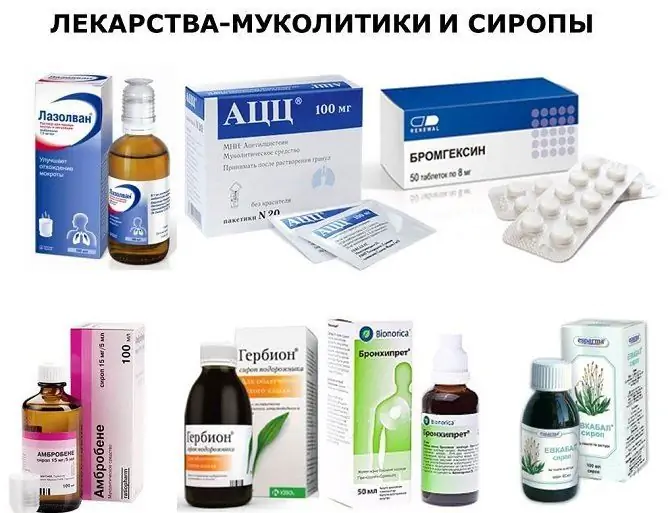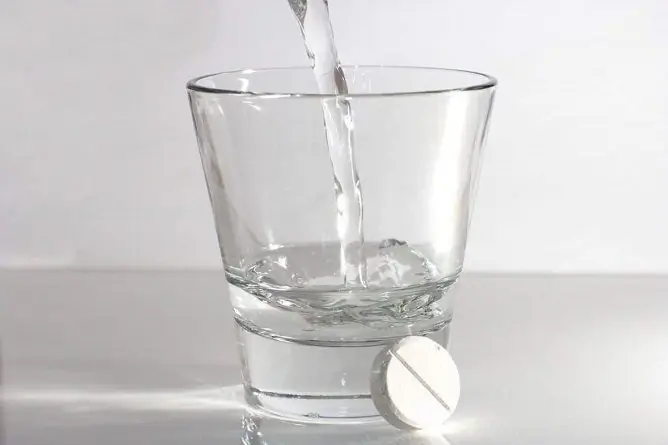Heartburn medications
The content of the article:
-
Classification of medicines
- Proton pump blockers
- H2 receptor antagonists
- M-anticholinergics
- Antacids
- Gastrocytoprotectors
- Antibacterial agents for eliminating Helicobacter pylori
- Treating heartburn caused by other causes
- Video
The selection of a cure for heartburn is based on the diagnosis that led to the onset of this symptom. Heartburn is based on the return of acidic gastric contents into the esophagus (gastroesophageal reflux) and, as a result, irritation and burning of the mucous membrane. There are many reasons for this phenomenon (unhealthy diet, stress, overweight), but in the first place are acute or chronic diseases of the stomach (gastroesophageal reflux disease, or GERD, peptic ulcer disease, gastritis). The prevalence is ubiquitous. There is no correlation dependence on gender. There is no dependence on age either.

Any medication for heartburn should be prescribed by a doctor.
Classification of medicines
The classification of drugs for heartburn can be represented as follows:
- Means that suppress the secretion of hydrochloric acid: proton pump blockers; antagonists H2-prescription, M-anticholinergics.
- Antibacterial agents for the destruction of Helicobacter pylori are included in the treatment regimen for some diseases accompanied by heartburn, but are prescribed only after histological and cytological confirmation of the diagnosis.
- Antacids.
- Gastrocytoprotectors.
The last two groups are used as symptomatic therapy.
Proton pump blockers
The most effective group of drugs for heartburn is to suppress the production of hydrochloric acid. After taking them, the acidity of gastric juice is significantly reduced, and the discomfort from the esophagus disappears.
The main prototype of this group on the market is Omeprazole. The rest of the drugs are represented by its analogs, which differ in price, speed and drug interactions.
List of drugs:
| A drug | Description |
| Omeprazole | It exists in the form of inexpensive domestic pills for heartburn, and is also available in pharmacies in the form of imported drugs (Omez). Difference in price. Produced more often in capsule form. Bioavailability no more than 60% (weak effect after the first dose). Long-term absorption - 1-2 hours. It is permissible to use it together with antacids, in part it has an antacid effect. Drink one capsule once a day (you can use it according to other schemes, which will depend on the underlying disease). We admit taking during pregnancy and lactation. |
| Esomeprazole | The main difference is in high bioavailability (up to 80%), that is, it has a pronounced effect from the first application. It is excreted through the liver, so the dose is selected taking into account concomitant diseases. |
| Pantoprazole | A distinctive feature of the drug is the absence of drug interactions (does not cause cross-reactions with other drugs). Bioavailability is about 78%. There are forms of release for intravenous use. Rapid elimination from the body (less than 4 hours). |

Omez is an imported drug of the group of proton pump blockers
Side effects for all drugs in this group:
- from the gastrointestinal tract (often) - constipation / diarrhea, pain, nausea, flatulence;
- from the nervous system (often) - headache, insomnia;
- from the liver and biliary system - laboratory increase in liver enzymes;
- from other organs and systems - there are side effects, but the frequency of their occurrence is minimal (1-2%).
H2 receptor antagonists
Blockers of histamine receptors (H2 receptors) are localized in the postsynaptic membrane (control of the work of the parietal cells of the stomach).
Examples of drugs: Cimetidine, Ranitidine, Famotidine and Nizatidine. Currently inferior to proton pump blockers. They are used in clinical practice less often than drugs of other groups.
Effects of reception:
- strengthening of the contractile function of the stomach (acceleration of emptying);
- suppression of the secretion of hydrochloric acid by inhibiting the work of parietal cells.
The peculiarity is low toxicity (less than 1% of the population is subject to adverse reactions).
Topical drugs:
| A drug | Description |
| Nizatidine | Has maximum bioavailability (90%). The maximum concentration in the blood after 1-2 hours. It is excreted by the kidneys in an unchanged form. Contraindicated in children under 12 years of age, pregnant and lactating. |
| Ranitidine | Has an average bioavailability (45-50%). Duration of action up to 12 hours. It is excreted by the kidneys (caution when administered to persons with renal failure). Available in tablet form. Contraindicated in children under 12 years of age, pregnant and lactating. |

Ranitidine - a drug of the group of H2-receptor antagonists
Side effects are the same for all drugs in this group:
- diarrhea / constipation;
- drowsiness and headache;
- skin rash;
- joint pain.
M-anticholinergics
Muscarinic receptors (M-cholinergic receptors) are receptors that are activated by muscarinic. In this case, we are talking about blocking nerve impulses through receptors further along the nervous system.
Receptor locations:
- Central nervous system;
- endings of postganglionic parasympathetic nerve fibers;
- endings of postganglionic sympathetic nerve fibers.
By localization, they are divided into:
- presynaptic;
- postsynaptic (M1, M2, M3).
M-anticholinergics are represented by tertiary and quaternary amines (the latter do not affect the central nervous system). Effects of blocking nerve impulses through muscarinic receptors (explains the use of these drugs against heartburn and other diseases of the stomach and esophagus):
- decreased secretion of all endocrine glands (including the production of hydrochloric acid and gastric enzymes);
- reduces the motor activity of the gastrointestinal tract and promotes relaxation of intestinal smooth muscles.
There are other effects, but they are not related to heartburn.
Used for peptic ulcer disease to relieve pain and reduce the secretion of hydrochloric acid. They are used relatively less frequently than drugs in other groups.

Gastrocepin - a drug of the group of M-anticholinergics
The most relevant drug in this group is Gastrocepin (pirenzepine). It does not penetrate the central nervous system (there are no side reactions such as psychosis and hallucinations). Available in different forms (tablets, injections, i / m and i / v). It has a small list of side effects (dry mouth, diarrhea, accommodation), but also low efficiency.
Antacids
Antacids are alkaline compounds that enter the stomach, combine with hydrochloric acid and neutralize it. Provide a good effect after the first application (relieve burning and pain). They are divided into system and non-system.
Non - systemic - they have a local effect and are not absorbed, these include preparations containing aluminum or magnesium compounds.
Properties:
- can be accepted by any age group;
- allowed during pregnancy and lactation;
- slow down the absorption of other drugs due to the fact that they form a film on the surface of the stomach;
- do not affect the production of gastric juice (hydrochloric acid in particular);
- more often available in the form of a gel;
- relatively cheap.
At the moment, two drugs are most relevant:
| A drug | Description |
| Maalox | The main active ingredients are magnesium hydroxide and aluminum hydroxide. Available in tablet form. It has no antisecretory effect. Suitable for use by pregnant women. Has a quick action (within half an hour). |
| Gaviscon | Although it contains calcium carbonate, it is not absorbed. Not recommended for children over 12 years of age. Requires a relatively frequent intake (every 4-6 hours) due to its rapid elimination from the body. |
Side effects of non-systemic drugs:
- constipation (caused by aluminum);
- diarrhea (caused by magnesium);
- hypophosphatemia and osteomalacia;
- hypokalemia and, as a result, arrhythmias;
- encephalopathy due to impaired renal function (especially with renal failure).

Gaviscon is a non-systemic antacid
Systemic - absorbed into the blood from the gastrointestinal tract (sodium bicarbonate, calcium carbonate).
They are used in extremely rare cases due to side effects:
- partial absorption of sodium into the blood and impaired water-salt metabolism in the kidneys (increased blood pressure, heart failure);
- partial absorption of calcium (causes hypercalcemia, severe alkalosis, risk of nephrolithiasis).
It is possible to use in case of emergency relief of heartburn in stationary conditions.
Gastrocytoprotectors
They are an aid in eliminating one of the causes of heartburn, namely peptic ulcer disease.
The main functions of this group:
- protection of the mucous membrane from damage;
- acceleration of the regeneration of already damaged areas of the stomach.
Examples of drugs:
| A drug | Description |
| Sucralfate | Not absorbed; when it enters the stomach, it interacts with hydrochloric acid to form a sticky substance. It seals the ulcers and prevents them from growing further. That is, it has a double effect: acid neutralization and the formation of a protective film around the damaged areas of the mucous membrane. |
| Bismuth subsalicylate (and other bismuth salts) |
Has three types of effects: weak antacid, bactericidal effect on Helicobacter pylori and the formation of a protective film around the ulcer. An unusual side effect is black stools (differential diagnosis with bleeding is required). In combination with other drugs, it has a pronounced clinical effect. |

Vitridinol - a preparation based on bismuth salt, gastrocytoprotector
Antibacterial agents for eliminating Helicobacter pylori
This group of drugs eliminates the main cause of gastritis (up to 75-80%) and, as a result, helps to remove heartburn, provided that it is caused by gastritis, and not by another gastrointestinal disease.
Helicobacter pylori is a gram-negative bacterium that is present in 80% of the population, but causes disease in only 20%.
Treatment regimens:
- Clarithromycin (500 mg 2 r / d), Amoxicillin (1 g 2 r / d), and Omeprazole (1 time per day).
- Clarithromycin (500 mg 2 times a day), Metronidazole (500 mg 2 times a day), and Omeprazole (2 times a day).
- Rifabutin (300 mg / d), Amoxicillin (1 g 2 r / d) and Omeprazole (2 times a day).
- Metronidazole 250 mg 4 r / d, Tetracycline 500 mg 4 r / d and Pepto-bismol 524 mg 4 r / d.
At the moment, you can find combined products in pharmacies:
- Pylobact (omeprazole + clarithromycin + tinidazole);
- Pylobact Neo.
The appointment of therapy is possible only based on the results of a biopsy (EGD). After the course of treatment, it is necessary to re-examine and evaluate the result.

Pilobact Neo - a combined preparation for the elimination of Helicobacter pylori
Treating heartburn caused by other causes
If there are reasons not related to gastrointestinal diseases, the following measures are necessary:
- If there is an error in the diet, a diet is shown (frequent, fractional meals with a predominance of plant foods).
- When taking certain medications (drugs for arterial hypertension, non-steroidal anti-inflammatory drugs) - replace the treatment regimen and group of drugs.
- During pregnancy (heartburn occurs due to increased intra-abdominal pressure) - only symptomatic treatment (antacids, Omeprazole).
- Refusal from alcoholic beverages and smoking.
As a rule, if you follow the rules of a healthy lifestyle, heartburn goes away on its own (in the absence of lesions from the gastrointestinal tract).
Video
We offer for viewing a video on the topic of the article.

Anna Kozlova Medical journalist About the author
Education: Rostov State Medical University, specialty "General Medicine".
Found a mistake in the text? Select it and press Ctrl + Enter.







